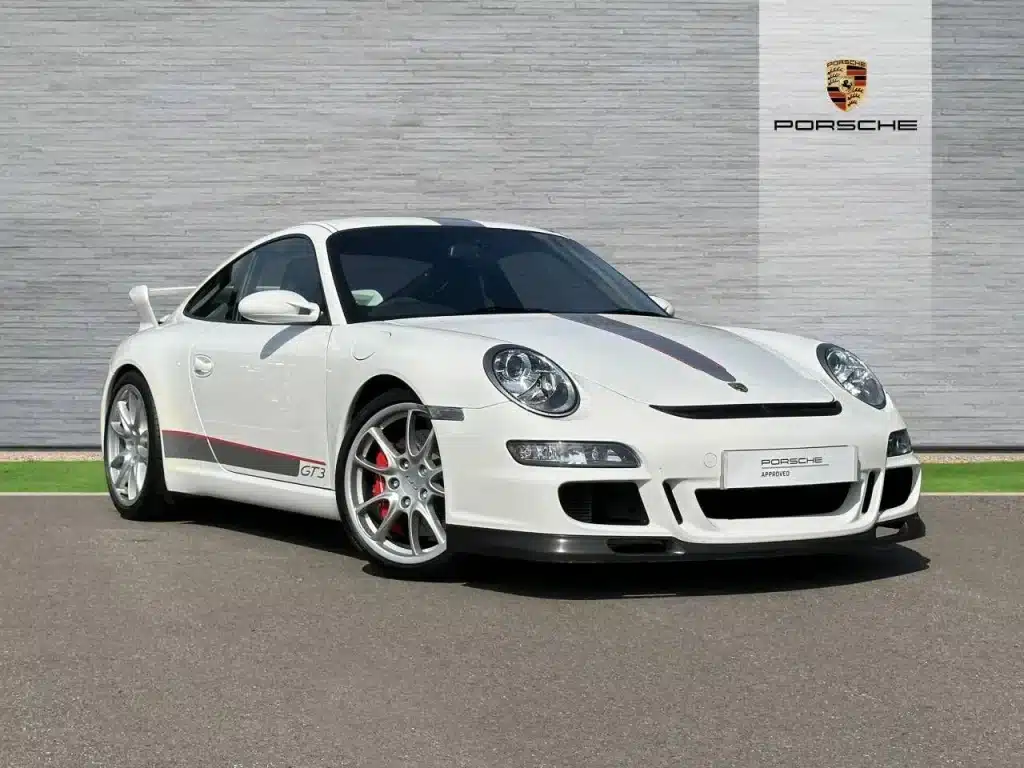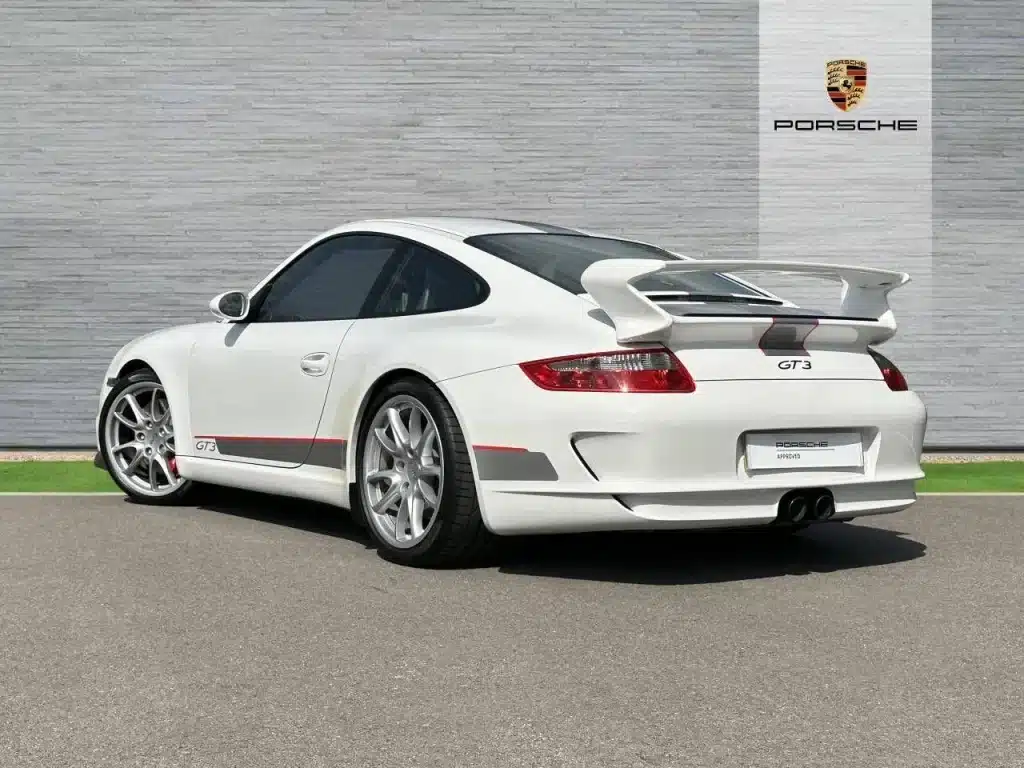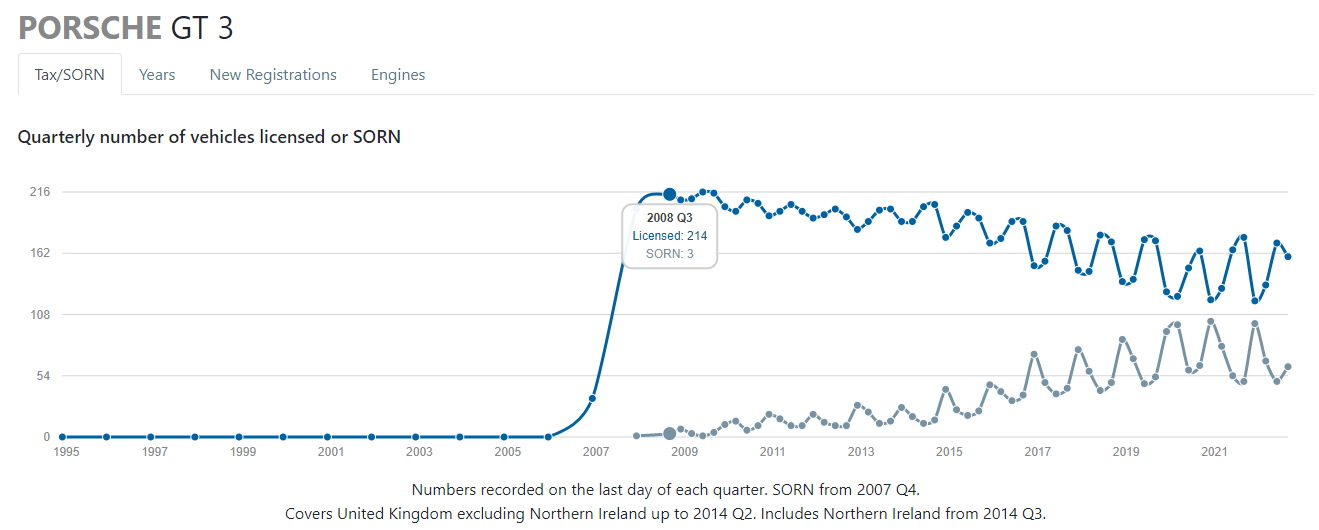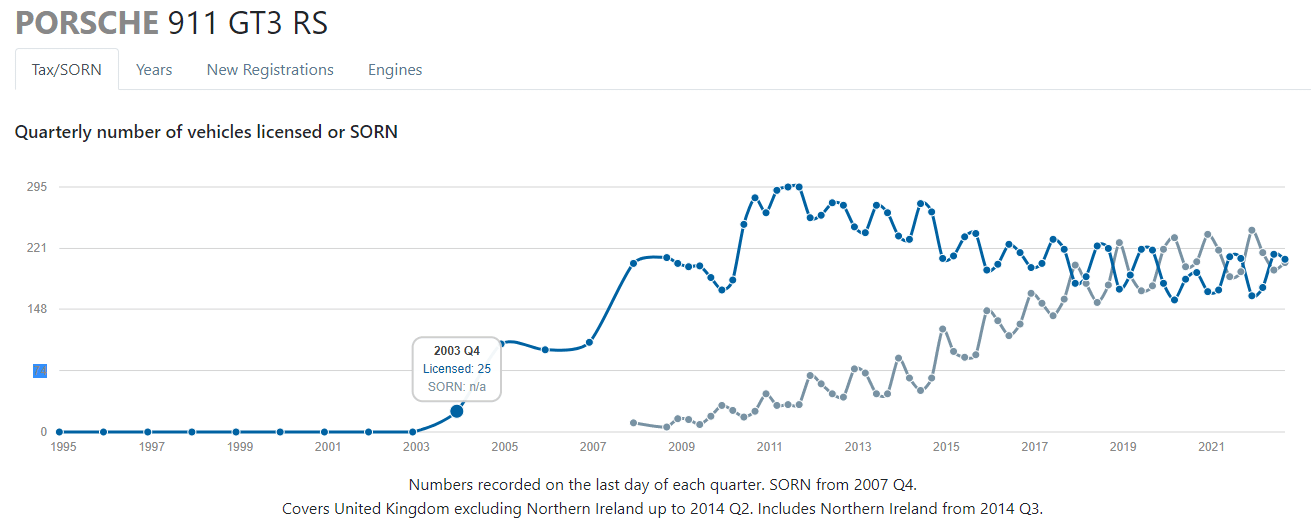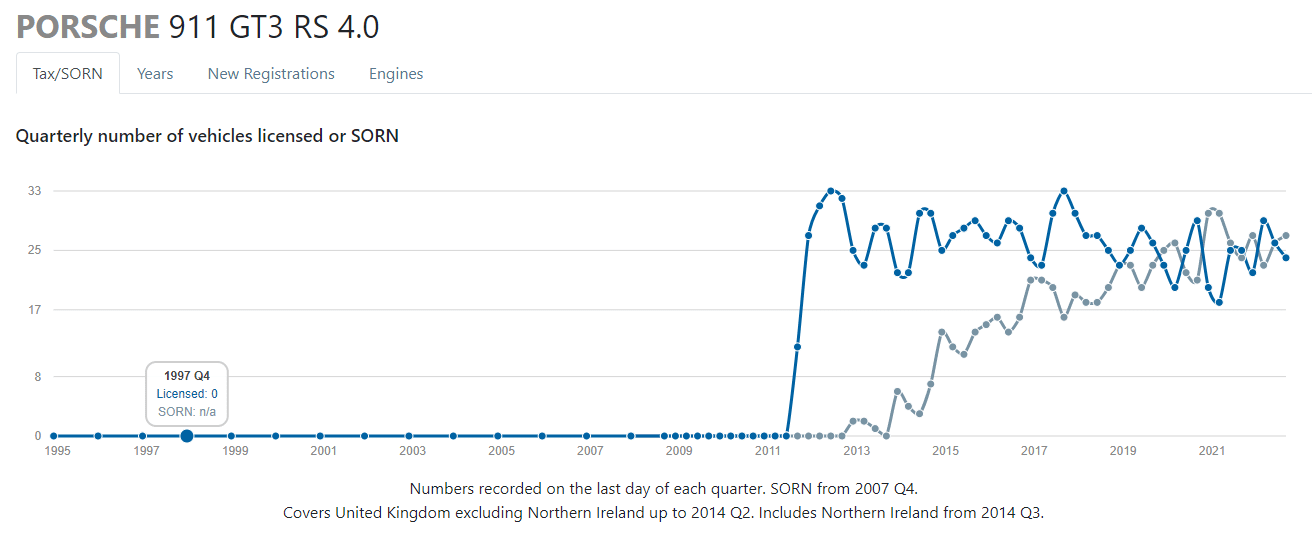Porsche 911 997.1 GT3Is This The Best 911 Ever Made
You can develop a sportscar from experience & from the heart
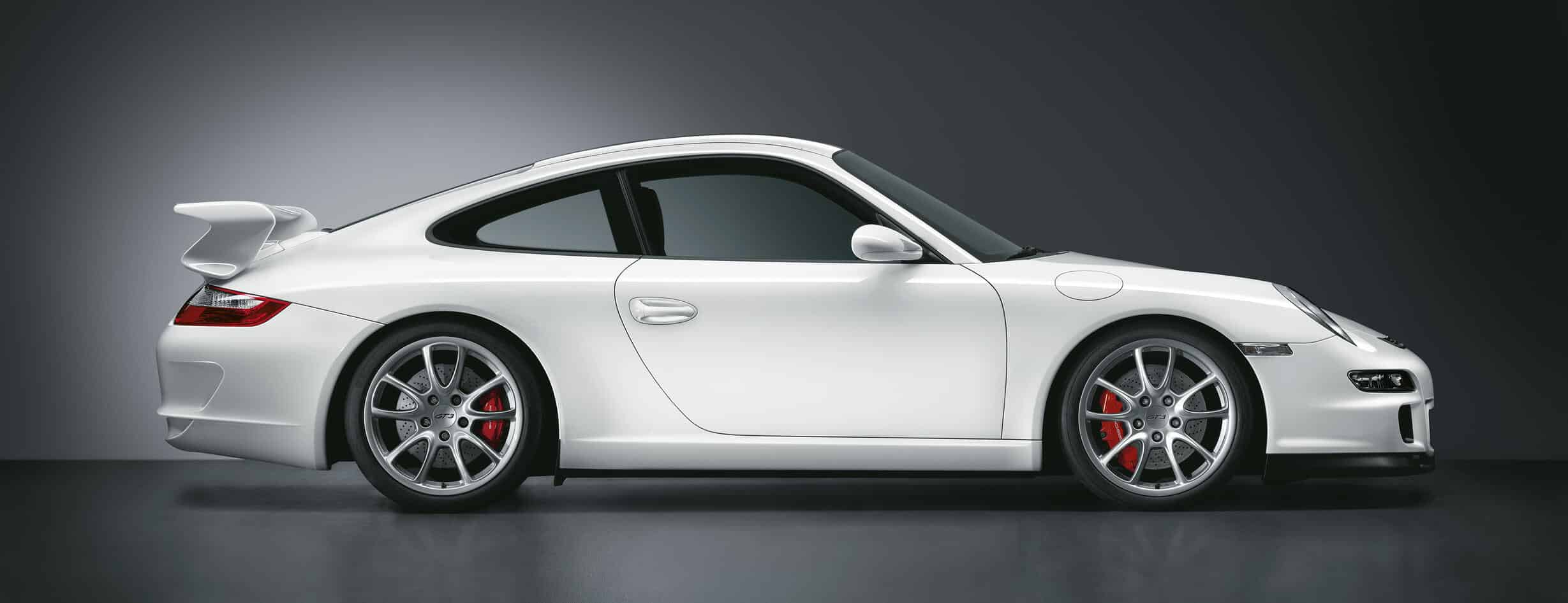
From a driver's perspective, the Porsche 911 997.1 GT3 will never happen again!
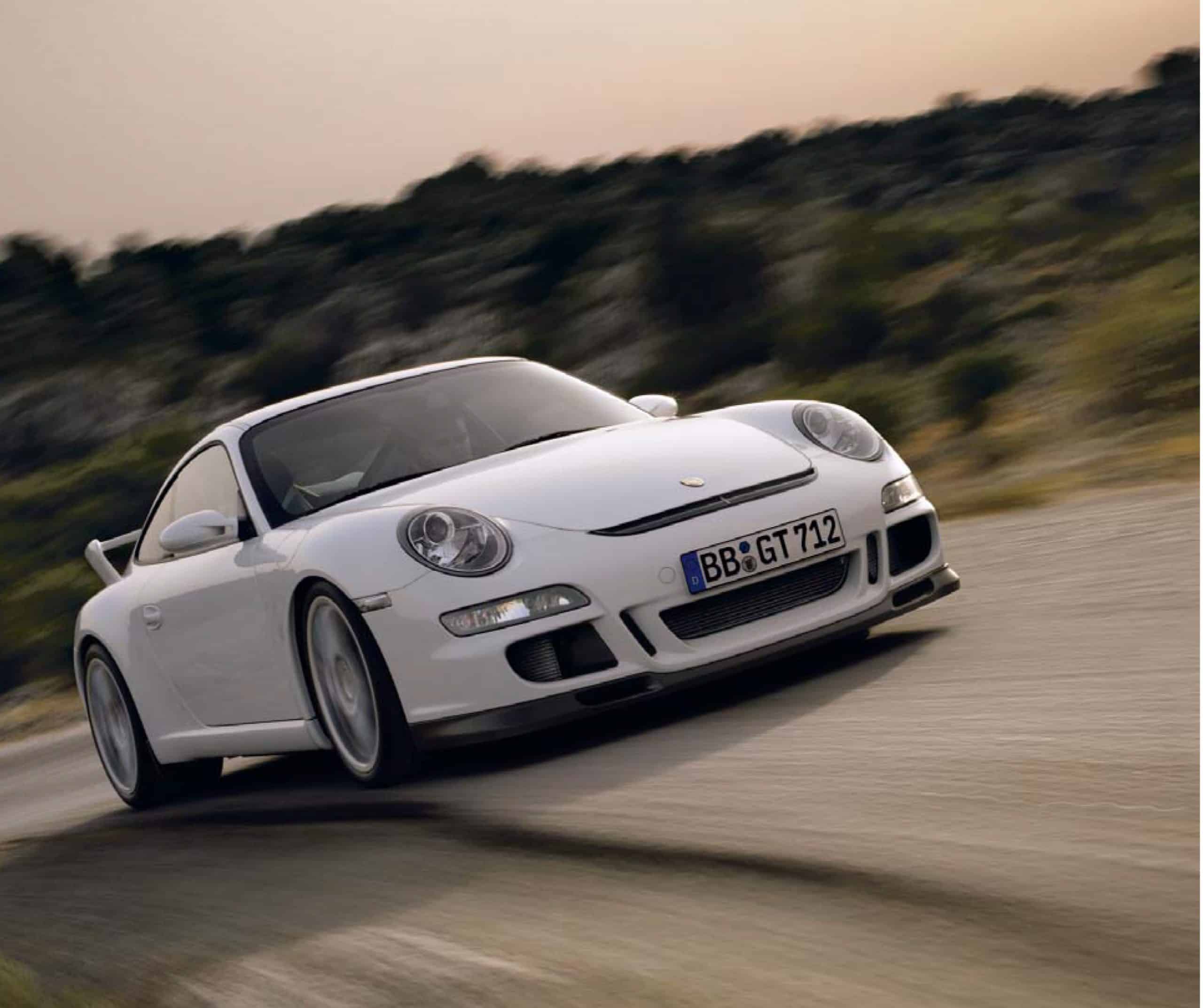
The Porsche 911 has been a staple in the world of sports cars for decades, with each iteration building upon the previous one's successes. The 997 generation of the 911 released in 2005 saw some significant improvements over the 996 and brought the love back to the 911 design with the return of the rounded headlights.
The release of the 911 997.1 GT3 in 2007 was the last release of a true analogue GT3 car and it stood out as a piece of Porsche's engineering history capable of weathering the future against any new car to be built, driving exactly how a true drivers car should drive and simply put doing everything just right with feeling and passion.
Comparing the 997.1 GT3 to the later 997.2 GT3 released in 2009, there are some comparable differences and then looking further at 991 and 992 the changes are vast. Exploring the differences between new technology and the reliability of its engine, future valuations and price today in the current market, the 997.1 GT3 is an investment car and can only be classed as a modern classic raw 911 GT model.
If you want possibly the best Porsche 911 road / race car ever made, buy a 997.1 GT3 today whilst you still can.
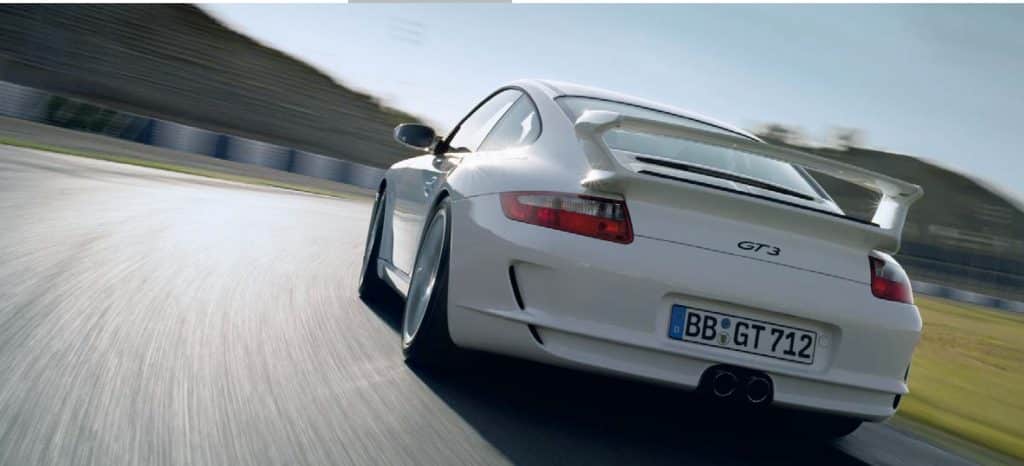
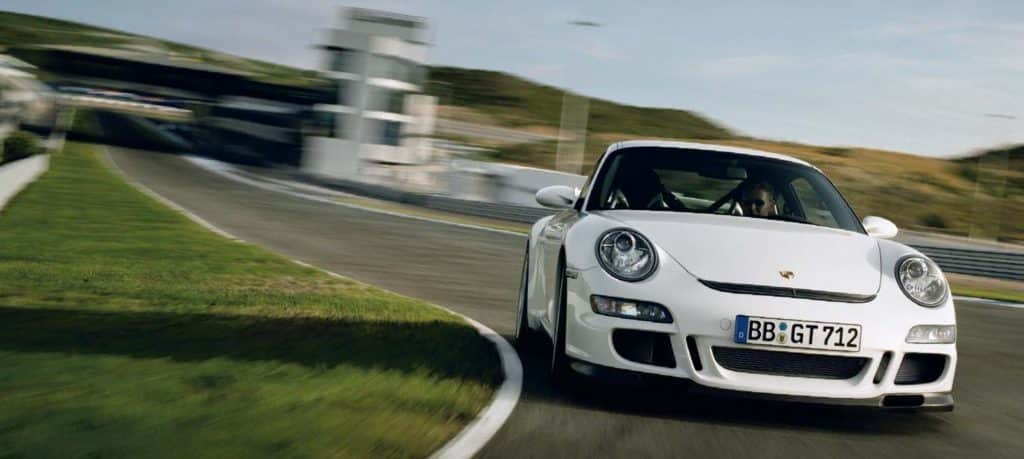
Why Is The Porsche 911 997 GT3 RS So Good Even Comparing It To The 992 GT3 RS
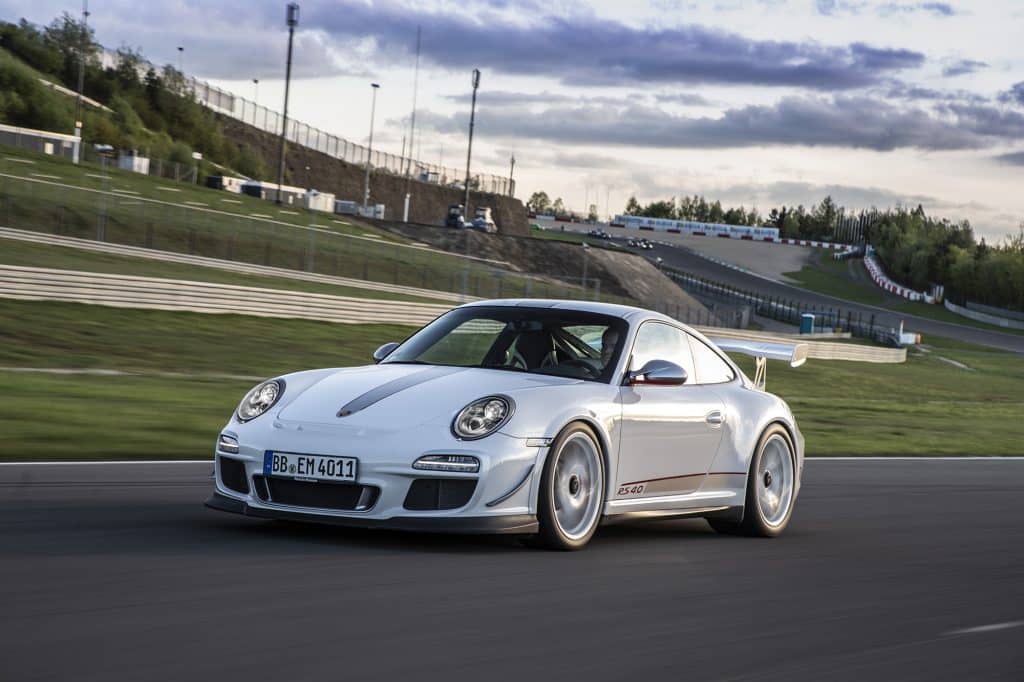
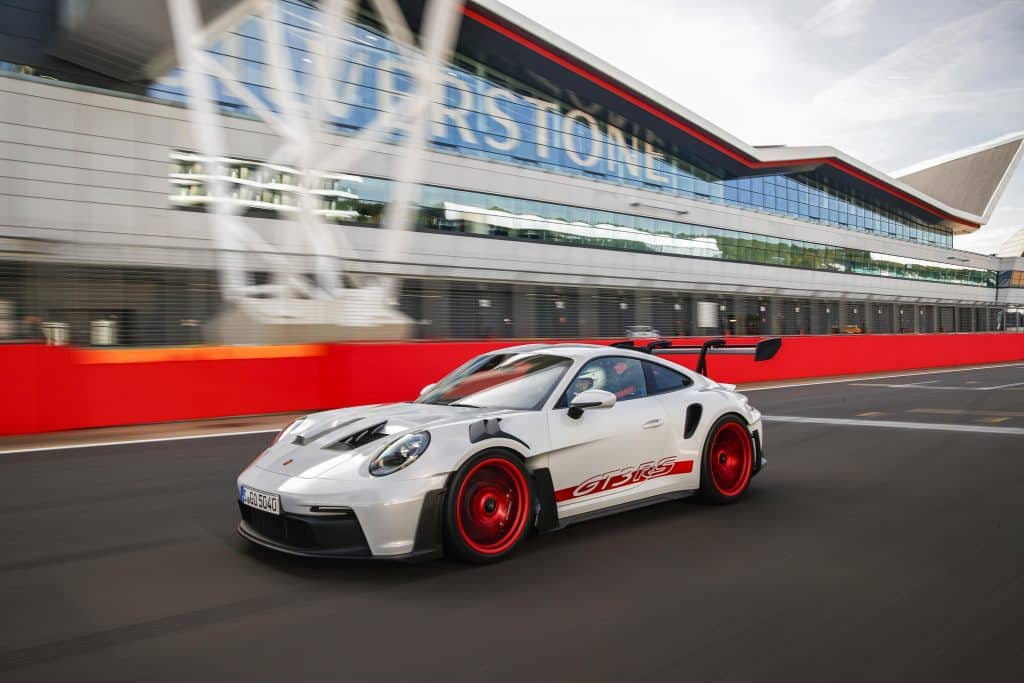
The Porsche 911 992 GT3 RS is technically one of the best cars to ever be made and all manufacturers will be using this as the pinnacle of performance. The results around a track speak for themselves, for a road car the track times are simply put unreal and comparable to non-road legal race cars. The 997 was the car that is behind this and the catalyst to become possible. In 2011 when Porsche released the Limited edition racing car, the 911 997 GT3 RS 4.0, limited to 600 vehicles, this 911 GT3 brought together in a road car all the attributes that have made the Porsche 911 GT3 a serial winner on the race track. This 997 at the Nürburgring-Nordschleife achieved a time of 7:27 minutes in 2011 and over a decade later the 992 GT3 RS achieved an unbelievable time of 6:49.328 minutes in October 2022.
The 911 992 GT3 RS is a piece of Porsche history for sure and one of the best cars ever made bringing the best of technology together to create a unique special road / race car. One of the main differences between the 997 and 992 was the focus of the aerodynamic development, to generate as much downforce as possible. The total downforce achieved by the 992 GT3 RS was 860 kgs and compared to the 997 GT3 RS which has a highly respected 190 kgs the difference is night and day and this means the car can achieve much higher speeds around the bends of any circuit. With the entire car being adjustable and downforce changes being made by the driver using steering wheel buttons, this is technology at its best.
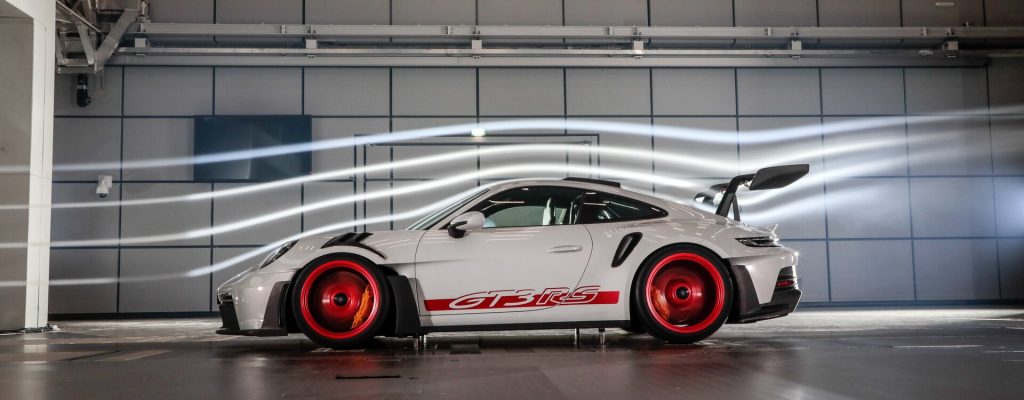
The 997 GT3 RS 4.0 was less sophisticated and in 2011 was breaking into new performance levels, Porsche has always based success on the fundamental principles of technical innovation and consistent application to the genuine needs of the driver and this 997 GT3 answered every question.
The price of a Porsche 911 997 GT3 RS 4.0 today is out of reach for most drivers and the 911 997 GT3 3.6 and 3.8 models are 95% the same car, so if you can afford a 997 GT3 you have what is considered to be the best 911 ever made.
Porsche 911 997 GT3
The Porsche 911 997 GT3 was an engineer's masterpiece, the resulting integration of driver and car comes from the racing victories over decades and the technology education on track produced an everyday road driving car that could be used for full competition use. The 911 GT3 is designed primarily for the road by Porsche race engineers and is exclusively track-derived yet perfectly suited to the varied requirements of day-to-day road driving.
What more can a driver want, the 997 GT3 provides an intuitive connection between man and machine, the sense of integration is so complete that you almost feel part of the car.
Feedback from the road is detailed and direct, while every driver input is immediately implemented with equal clarity and precision.
From a driver's perspective, the Porsche 911 997 GT3 will never happen again, technology has moved on and for the right reasons as our technological world continues at such a fast pace. Today's questions being asked by hyper manufacturers are things like do we need to get a car to achieve 300 mph and whether the majority of these amazing machines produced today will ever see a road makes these machines pieces of automotive artwork in multimillionaires home. These truly amazing cars lack true passion and this is something that will never come back, for this reason, the 997 GT3 is a car for true drivers to enjoy, and the 911 is a car you can drive to the track, around the track and drive home visiting the shops on the way home, it does everything and to the best of its ability every time.
The Porsche 911 997 GT3 was the point of change in the car world and for many will go down in history as the best car ever built that connected the driver to the road with confidence and every drive made your hairs stand up on end.
Porsche 911 996 GT3 Compared to 997 GT3
The Porsche 911 996 GT3 has to be mentioned because it allowed the 997 to be developed into the amazing car it is. The 996 is a great car all round and some say possibly one of the best track GT3s for fun and driving feedback. The 997.1 was subtle changes to improve the 996, mostly the body shape as previously mentioned moved from the egg-shaped headlights and small rear end in the 996 to the rounded wider rear on the 997 and the visual differences are clear. It is said that the 997 is the best-looking 911 ever made before the 991 which made the car larger and more aggressive looking.
The Porsche 911 997.1 3.6 Engine
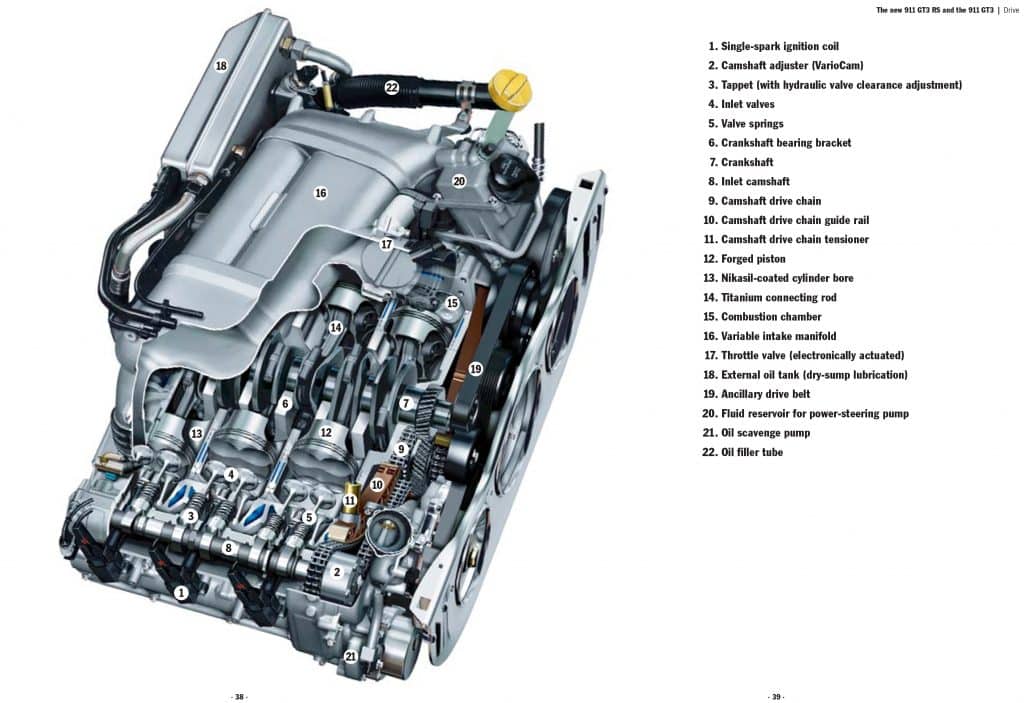
The 911 997.1 GT3 has the last true Mezger engine which was a 3.6 litre flat-six engine originally developed for the racetrack. The maximum power output is 305 kW (415 bhp) at 7,600 rpm with the maximum torque rating being 405 Nm at 5,500 rpm. This truly amazing engines rev limit is unusually high at 8,400 rpm and as impressive as the figures appear on paper, they can only be appreciated on the road.
The engine coupled with the chassis provides a power-to-weight ratio of 297.5 bhp per tonne and provides the driver with 0 to 100 km/h (62 mph) in
4.3 seconds, and a maximum speed of 310 km/h (193 mph) which some might say there are now sub 3 seconds to 60 cars now, but the reality is when the driver is fully connected to the road, the motorsport soundtrack and the power curve produced makes this 0 to 60 time irrelevant, this is a car for driving and the power and gear ratio is matched to perfection and on a twisty road there is no better feeling.
The 911 997.1 GT3 with the 3.6 engine is a driver's engine, the noise of it is like no other and all of this potential is applied with accuracy through a six-speed manual gearbox and high-performance chassis featuring Porsche Active Suspension Management making this car drive so special.
As far as naturally aspirated engines go this has to be one of the best ever made. The Mezger engine is world-class in motorsport competitions which powered the 911 to a GT1 class win at Le Mans in 1998. Hans Mezger was the absolute authority on engines at Porsche and developed the air-cooled six-cylinder boxer engine of the 911.
All components in the engine cooling system are directly sourced from Porsche Motorsport. They are therefore engineered for both maximum performance and durability.
Oil is evenly distributed under all load conditions thanks to a dry-sump lubrication system with external tank. After passing through the engine, the oil is
cooled by means of a dedicated oil-water heat exchanger. Both of these systems are proven in competition use.
Ultra-lightweight titanium connecting rods and specially lightened pistons help to further reduce the oscillating masses, enabling a more dynamic, freerevving throttle response. The valvegear also benefits from technology originally developed for racing engines. The inlet and exhaust valves have ultralight tappets with hydraulic valve clearance adjustment. Aided by these features, the 911 GT3 engine has a maximum speed of 8,400 rpm. This higher rev limit allows a closer drop betweenindividual gear ratios and thus faster acceleration.
Adding to this potential is a variable-geometry intake manifold with two ‘resonance’ valves. Working in conjunction with the sports exhaust system, the intake manifold improves cylinder charging and achieves a higher throughput of air.
The large-diameter exhaust tracts generate less backpressure, thus easing the flow of incoming air through the low-resistance intake manifold. The results: increased power and torque.
Both inlet camshafts feature steplessly variable valve timing (VarioCam). Key benefits include lower emissions and higher performance depending
on current driver inputs. The system is active over the entire engine speed range.
Combined, these technologies provide a throttle response that is always emphatic and direct.
Accompanying it all is the distinctive sound of a race-bred Porsche engine.
The Porsche 911 997.2 3.8 Engine
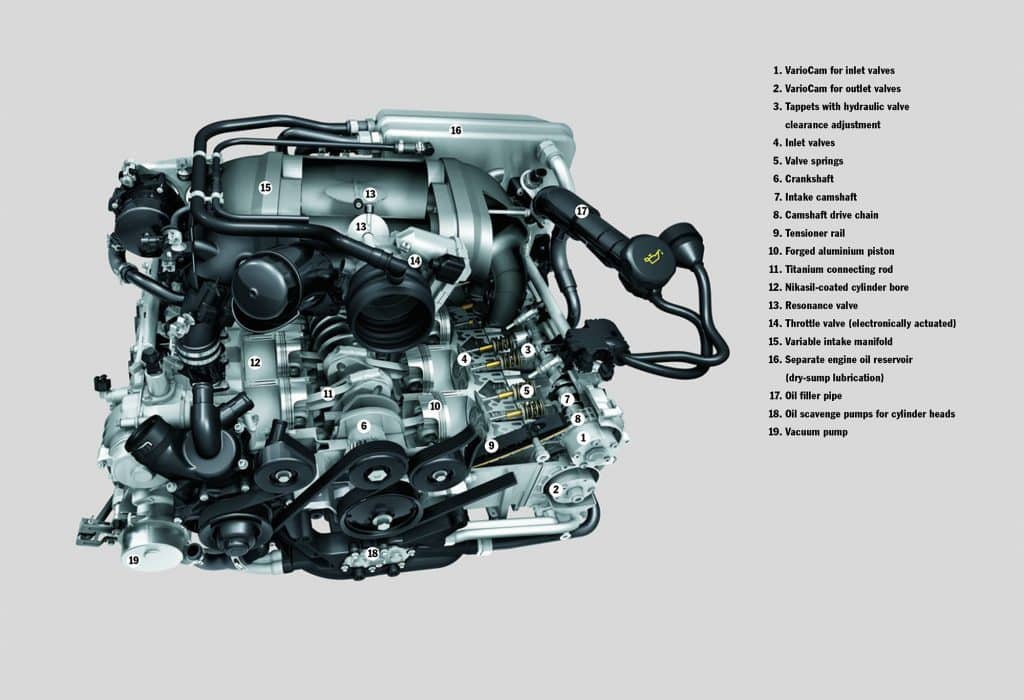
The 991 997.2 GT3 had an increased cubic capacity of 3.8 litres. The engine used advanced VarioCam, a system for adjusting the inlet camshafts, and now also the outlet camshafts producing more power and higher torque, resulting in 320 kW (435 hp) at 7,600 rpm with the maximum engine speed at 8,500 rpm and maximum torque is 430 Nm at 6,250 rpm.
Using a six-speed manual gearbox effectively transmitting this power onto the road the 997.2 GT3 achieved 4.1 seconds from 0 to 100 km/h (62 mph) and 312 km/h (194 mph).
Also the 997.2 brought for the first time into a 911 GT3, Porsche Stability Management (PSM) with two control systems. Stability Control (SC) to provide stabilisation within the limits of driving dynamics and Traction Control (TC) to regulate the longitudinal dynamics and improve acceleration on various
road surfaces. Both systems can be disabled completely in two stages – for an active driving experience on the racetrack.
One large difference with the 997.2 is the introduction of the central locking device for the wheels.
Everything on the new 911 GT3 997.2 is designed to save weight. The doors and front lid are made from aluminium and the new engine cover is made from a lightweight synthetic material. The result is a weight-to-power ratio of just 3.2 kg per hp.
One advantage over the 997.1 is that the 997.2 had an optional ride-height lift system for the front axle which at low speeds allows the front of the vehicle to be raised by 30 mm if there is a risk of it grounding.
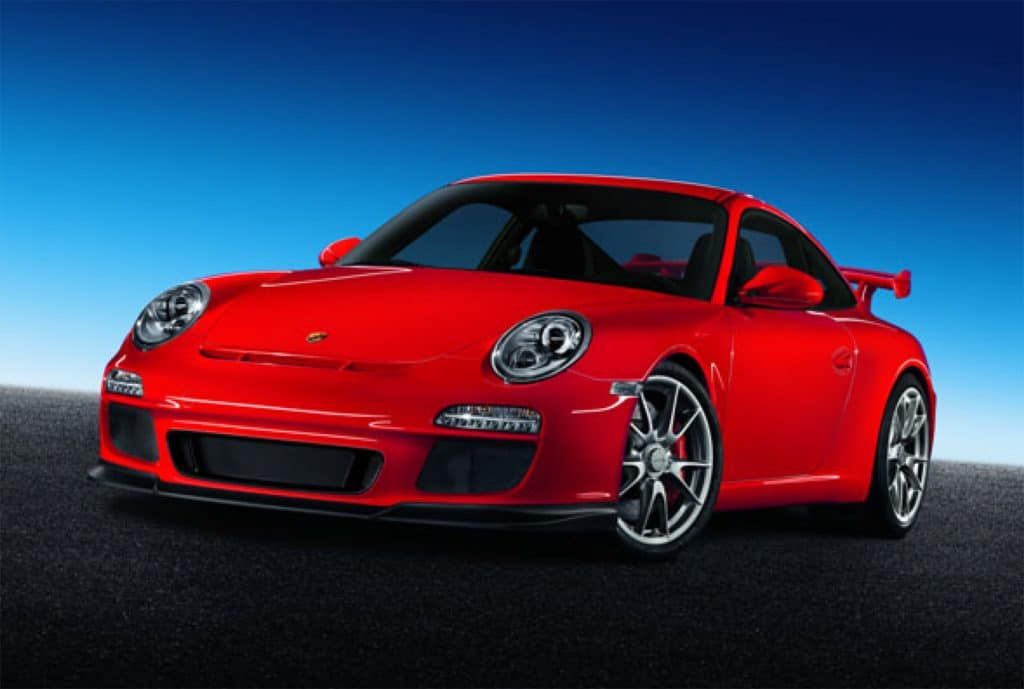

Another visual difference is the rear spoiler, embossed on the side of the rear wing is ‘3.8’. A reference to the engine size and a clear indication of its power.
Another change is the lights on the 911 GT3 997.2 has Bi-Xenon headlights fitted as standard. Indicators and LED daytime running lights are harmoniously integrated into the separate front light units over the outer air intakes. At the rear, distinctive LED lights are drawn right into the wing and
taper outwards.
Porsche 911 997.1 vs 997.2 Explained
Porsche 911 997 GT3 Build Numbers
There is not much difference between the build number globally:-
| Generation | Years of | Engine | Units Built | Difference to 997.1 GT3 (2,378) |
| Production | Displ. (cm³) | |||
| 996.1 GT3 | 1999–2001 | 3,600 | 1,868 | -510 |
| 996.2 GT3 | 2003–2005 | 3,600 | 2,313 | -65 |
| 997.1 GT3 | 2006–2009 | 3,600 | 2,378 | x |
| 997.2 GT3 | 2009–2011 | 3,797 | 2,256 | -122 |
| 991.1 GT3 | 2013–2016 | 3,799 | 6,300 | 3,922 |
| 991.2 GT3 | 2017– | 3,996 | 9,500 | 7,122 |
| Generation | Years of | Engine | Units Built | Difference to 997.1 GT3 RS (1,106) |
| Production | Displ. (cm³) | |||
| 996.2 GT3 RS | 2003–2004 | 3,600 | 682 | -424 |
| 997.1 GT3 RS | 2006–2009 | 3,600 | 1,106 | x |
| 997.2 GT3 RS | 2009–2011 | 3,797 | 2,000 | 894 |
| 997.2 GT3 RS 4.0 | 2011 | 3,996 | 600 | -506 |
| 991.1 GT3 RS | 2016–2017 | 3,996 | 4,500 | 3,394 |
| 991.2 GT3 RS | 2018– | 3,996 | 4,880 | 3,774 |
The build numbers of the 996 and 997 are so limited in comparison to the 991 generation cars.
| Generation | Units Built |
| 996 GT3 / RS | 4,863 |
| 997 GT3 / RS | 8,340 |
| 991 GT3 / RS | 25,180 |
If you are a UK owner wanting a RHD then only 248 units of 997.1 GT3 cars were ever produced. The 997.2 numbers are more difficult to confirm with figures around 166 units in RHD.
911 997.1 GT3 3.6 Engine
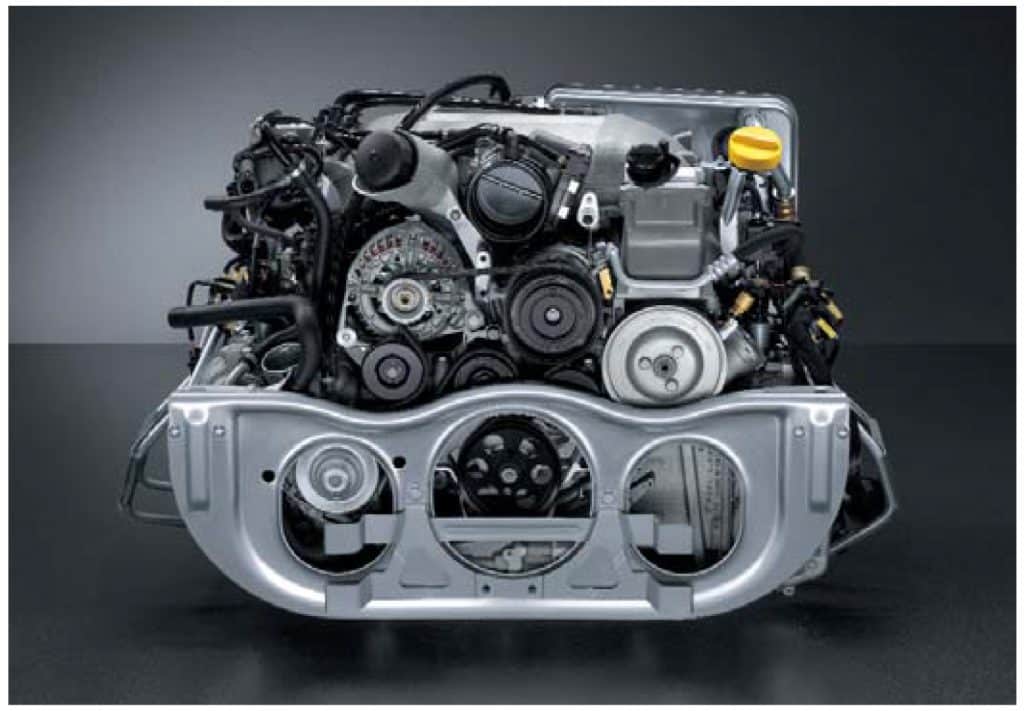
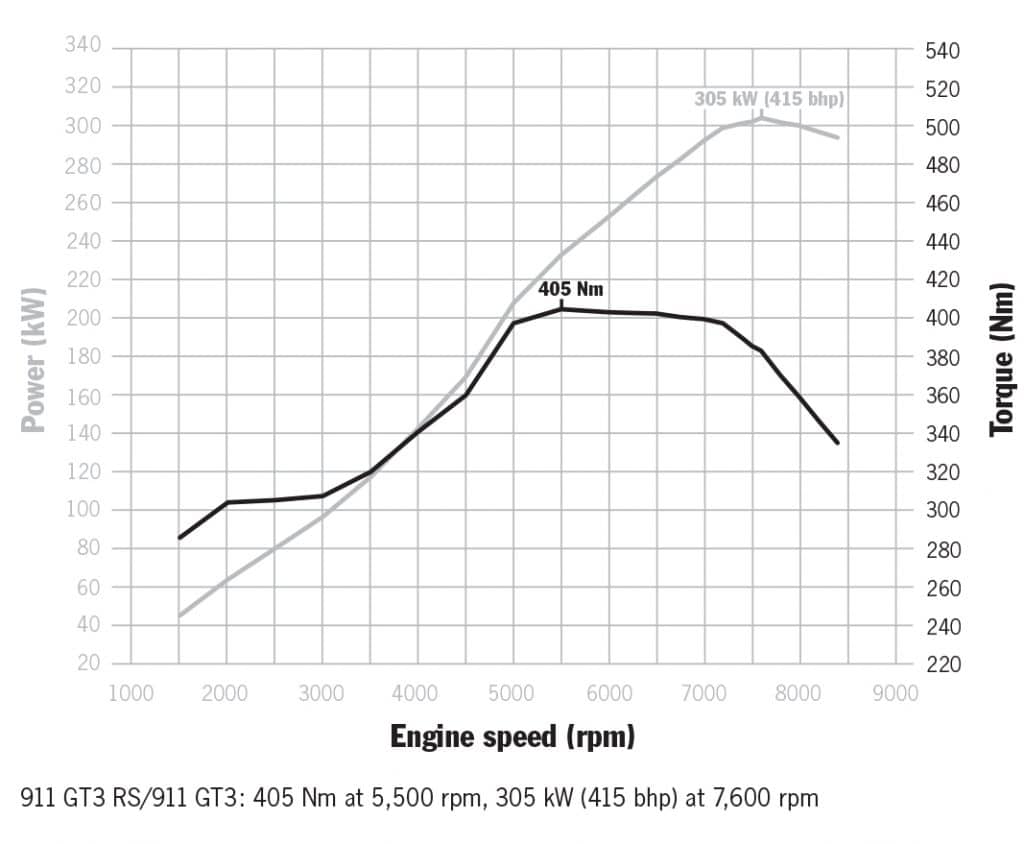
3.6 Litre
Start of production = 2006 year
End of production = 2009 year
Powertrain Architecture = Internal Combustion engine
| Acceleration 0 - 100 km/h | 4.3 sec |
|---|
Weight-to-power ratio = 3.4 kg/Hp, 297.5 Hp/tonne
Weight-to-torque ratio = 3.4 kg/Nm, 290.3 Nm/tonne
| Power | 415 Hp @ 7600 rpm. |
| Power per litre | 115.3 Hp/l |
| Torque | 405 Nm @ 5500 rpm. |
| 298.71 lb.-ft. @ 5500 rpm. | |
| Engine layout | Rear, Longitudinal |
| Engine Model/Code | M97.76 |
| Engine displacement | 3600 cm3 |
| 219.69 cu. in. | |
| Number of cylinders | 6 |
| Engine configuration | Boxer |
| Compression ratio | 12 |
| Number of valves per cylinder | 4 |
| Fuel injection system | Multi-point indirect injection |
| Engine aspiration | Naturally aspirated engine |
| Valvetrain | DOHC |
| Sump | Dry Sump |
| Engine oil capacity | 9 l |
| 9.51 US qt | 7.92 UK qt |
911 997.2 GT3 3.8 Engine
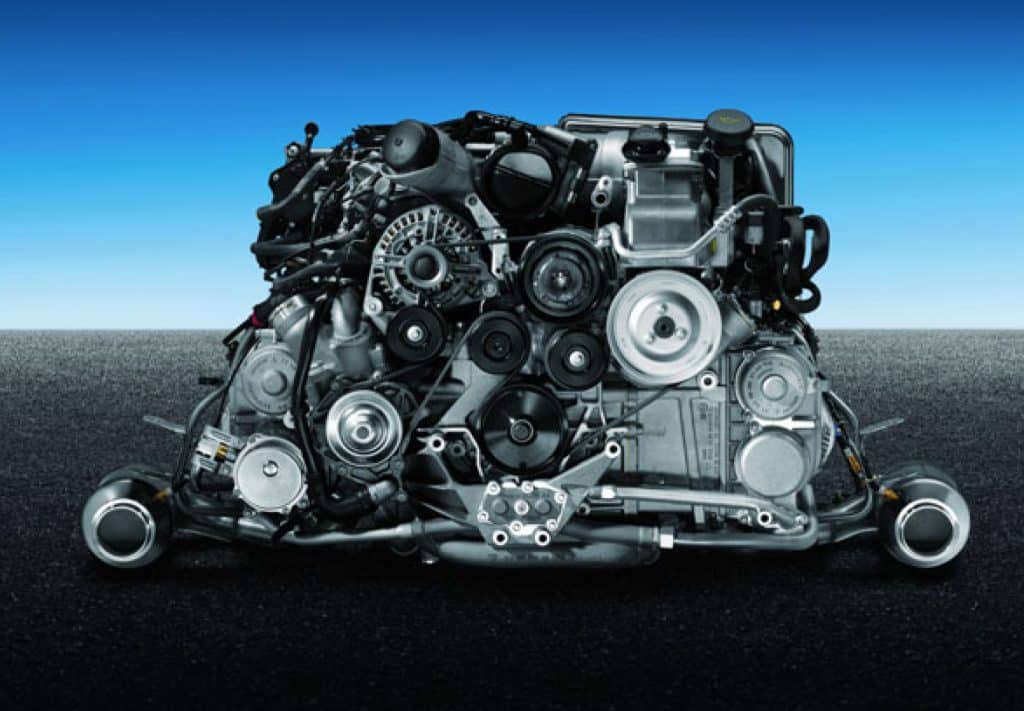
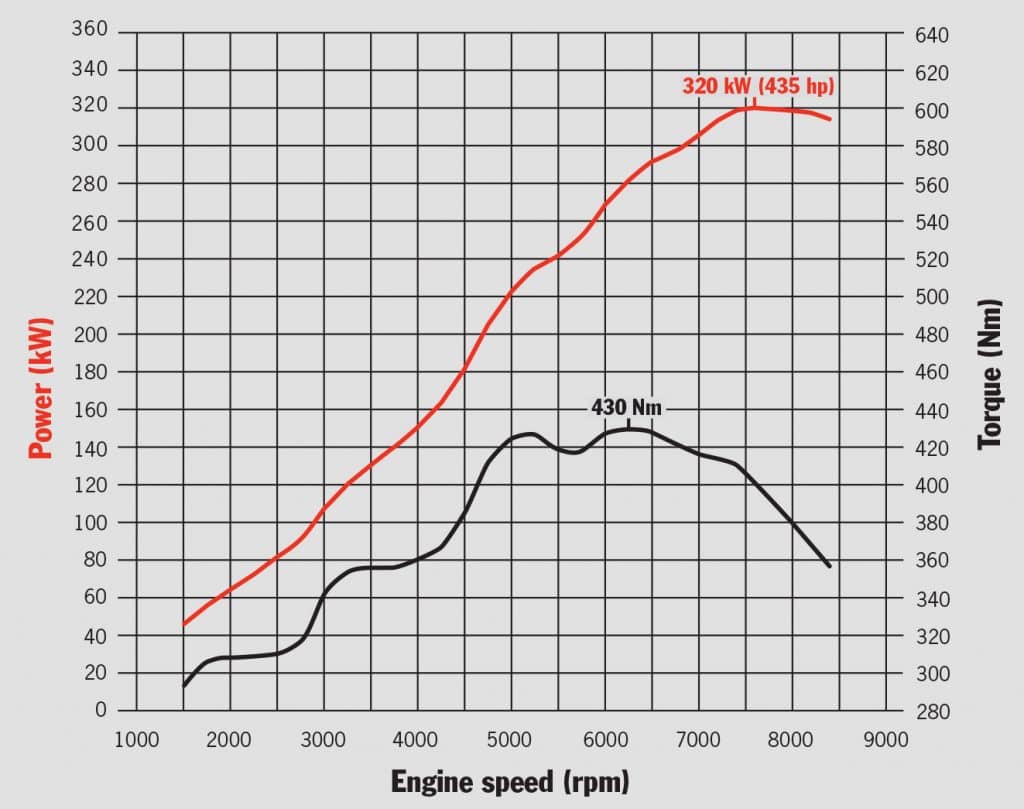
3.8 Litre
Start of production = 2009 year
End of production = 2011 year
Powertrain Architecture = Internal Combustion engine
| Acceleration 0 - 100 km/h | 4.1 sec |
|---|
Weight-to-power ratio = 3.2 kg/Hp, 311.8 Hp/tonne
Weight-to-torque ratio = 3.2 kg/Nm, 308.2 Nm/tonne
| Power | 435 Hp @ 7600 rpm. |
| Power per litre | 114.6 Hp/l |
| Torque | 430 Nm @ 6250 rpm. |
| 317.15 lb.-ft. @ 6250 rpm. | |
| Engine layout | Rear, Longitudinal |
| Engine Model/Code | M97.77 |
| Engine displacement | 3797 cm3 |
| 231.71 cu. in. | |
| Number of cylinders | 6 |
| Engine configuration | Boxer |
| Compression ratio | 12 |
| Number of valves per cylinder | 4 |
| Fuel injection system | Direct injection |
| Engine aspiration | Naturally aspirated engine |
| Valvetrain | DOHC |
| Sump | Semi-dry Sump |
| Engine oil capacity | 9 l |
| 9.51 US qt | 7.92 UK qt |
Engine & Gearbox
The 997 GT3 is one of the last Porsches to be equipped with a Mezger engine which was discontinued with the introduction of the 991. The Mezger engine is directly inherited from the 911 GT1 and its true motorsport relationship goes even further sharing with the Porsche 962 and 956.
If we look at the engine and gearbox of Porsche 911 997.1 and 997.2 we can find many differences. The 3.6 is a multi-point indirect injection with dry sump compared to the 3.8 which is a direct injection with semi-dry sump.
The 997.1 was available as M97.76 which was 3.6 litres only delivering 415hp at 7600rpm and a maximum torque of 405Nm at 5500rpm. The engine revs freely and red lines at 8400rpm due to upgraded race-bred lighter internal components. The 30-gram lighter pistons and 600-gram lighter crankshaft and titanium conrods allow this engine to spin up like no other.
The development of a new engine is always challenging and as the strict requirements of international emissions standards such as Euro 5 in
Europe and LEV II in the USA manufacturers are forced to improve engine design the new 3.8 provided improved fuel efficiency and reduced emissions with an increase in power. Other changes took place including the supply of oil to the engine with semi-dry sump lubrication system with an external engine oil reservoir. The oil is cooled by an oil-water heat exchanger.
Extremely lightweight titanium connecting rod and lighter pistons reduce oscillating masses, thus ensuring dynamic engine speed development. The inlet and exhaust valves are actuated by extremely lightweight tappets and hydraulic valve clearance adjustment. This enables a maximum engine speed of 8,500 rpm.
The oil pumps are designed so that there is negative pressure in the crankcase. This reduces resistance to the movement of the pistons to improve power output and efficiency. Another pump in the crankcase supplies the lubricating points in the engine from the external reservoir.
For the engine this means consistent lubrication of the crankshaft assembly and the two cylinder banks, even under the extreme lateral and longitudinal loads. Once the oil has passed through the engine, two scavenge pumps in each cylinder head and another two in the crankcase take the engine oil quickly and efficiently back to an external reservoir.
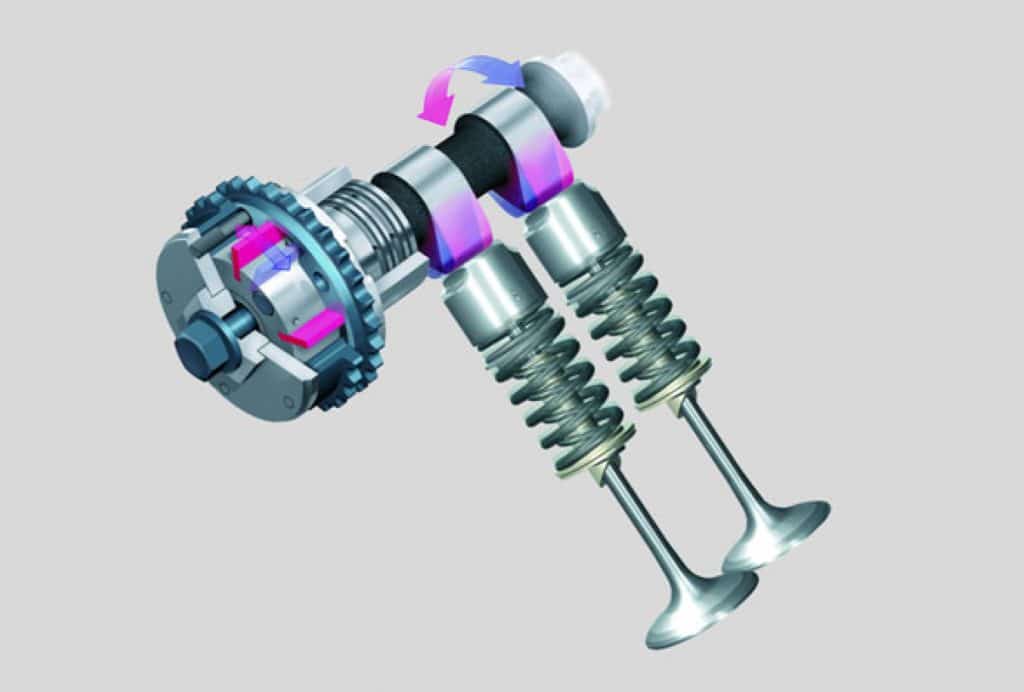
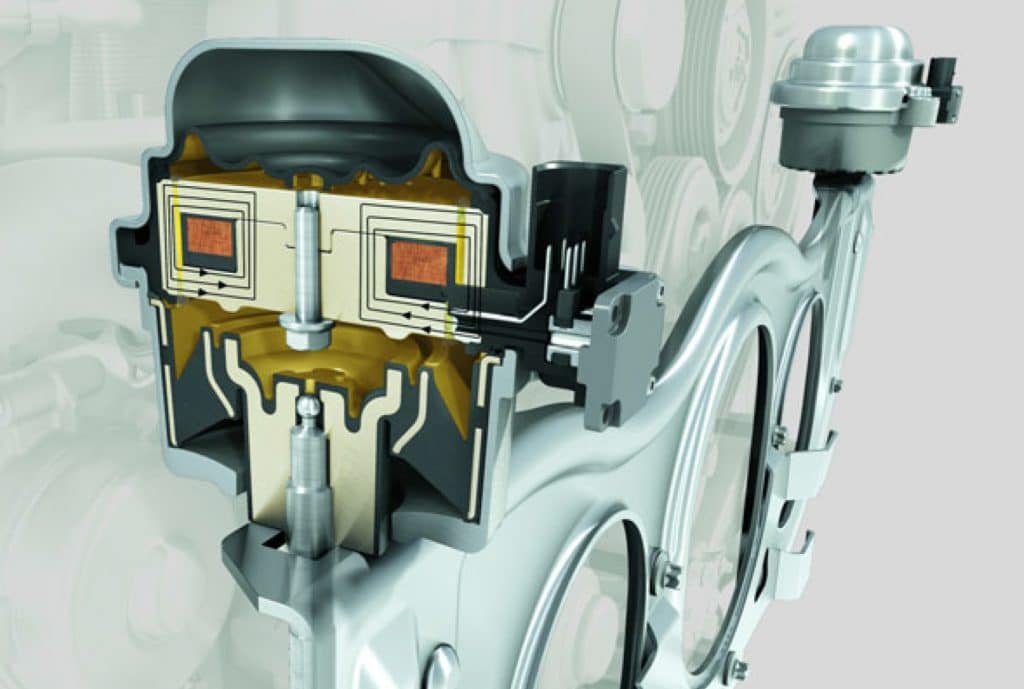
For the first time, the engine in the 911 997.2 GT3 is equipped with enhanced VarioCam.This improved system not only adjusts the camshafts on the inlet side according to engine speed and load, it now also controls the exhaust camshaft – for even more power and torque. The continuous valve timing adjustment is performed by a rotary-type adjuster on each camshaft. VarioCam is an engine control concept that distinguishes between different load scenarios and adapts to the corresponding power requirement.
The adjustment is performed seamlessly by the Motronic ME7.8.2 electronic engine management system. This enables smoother running characteristics, better fuel economy, lower exhaust emissions and, most importantly of all, added power and torque across the entire engine speed range.
Also used in the 997.2 is the newly developed and available as an option, the new dynamic engine mount system. This electronically controlled system minimises noticeable oscillations and vibrations in the whole drive system, particularly the engine.
The engine is bolted to the body using two mounts. According to Newton’s law of inertia, a body will continue to move in a uniform straight line unless it is made to change its direction by a force acting upon it. Put more simply: when you are driving into a bend in your new 911 GT3, the vehicle will follow your steering but, at first, the mass of the engine won’t. This means that the rear of the vehicle is pushed outwards because of the inert forces from
the engine’s mass acting on it.
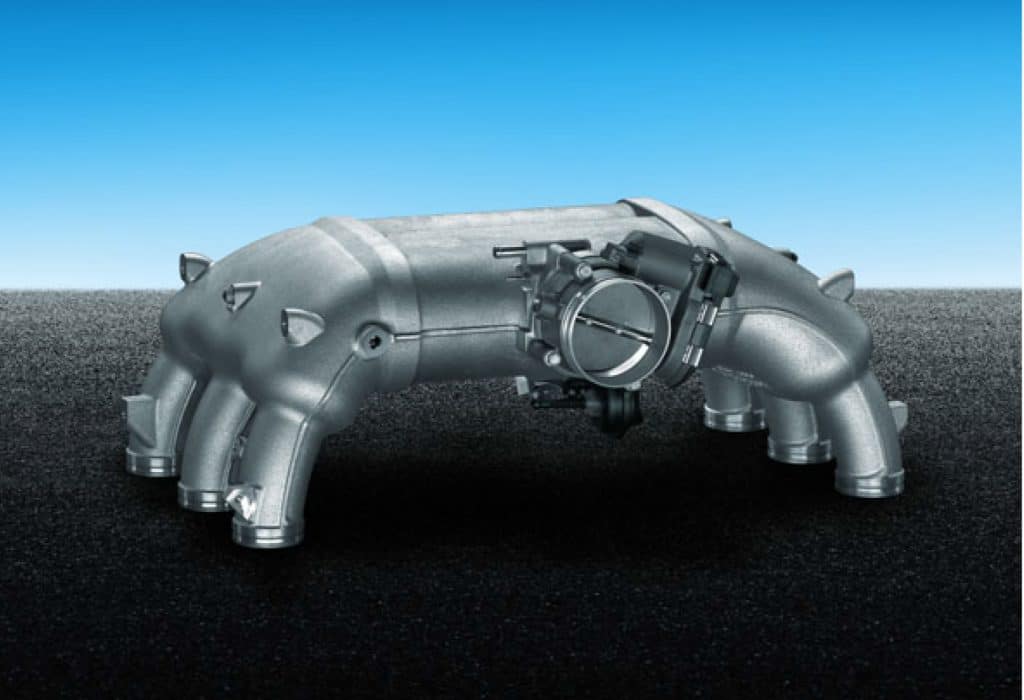
The variable intake manifold with two resonance valves which work together with the sports exhaust system to ensure efficient cylinder charging and high throughput rates. The large volume of the exhaust system supplements the low-resistance intake manifold to improve cylinder charging and increase performance.
The 3.6 engine develops a different power curve, higher horsepower in the rpm range and a faster revving engine due to the lightness of its components such as pistons, valvetrain, and flywheel.
The 3.8 loses some of this free-revving effect of lightness in the rotating mass due to more mass in the rotating components, however, it will produce more torque lower down. Race cars depend on lots of horse power high in the rpm range to be most effective and not so much on torque.
If you look at the torque numbers of the 997 3.8 and the 3.6 GT3, they are very close, the faster spinning free revving 3.6 provides a better experience to the driver.
Both 997 versions of the GT3 have adaptive damping with traction control and PASM (Porsche Active Suspension Management) with a selectable firmer mode for track use. The traction control (TC) has a mechanical locking differential providing around 28% lock-up under power and 40% on overrun.
The traction control on the 997 GT3 is taken from the Carrera GT and allow wheelspin but functions when it becomes excessive.
This system also has the ability to limit engine-braking on the overrun preventing locking up the wheels on downshifts which can be turned off.
Porsche 911 997.1 GT3
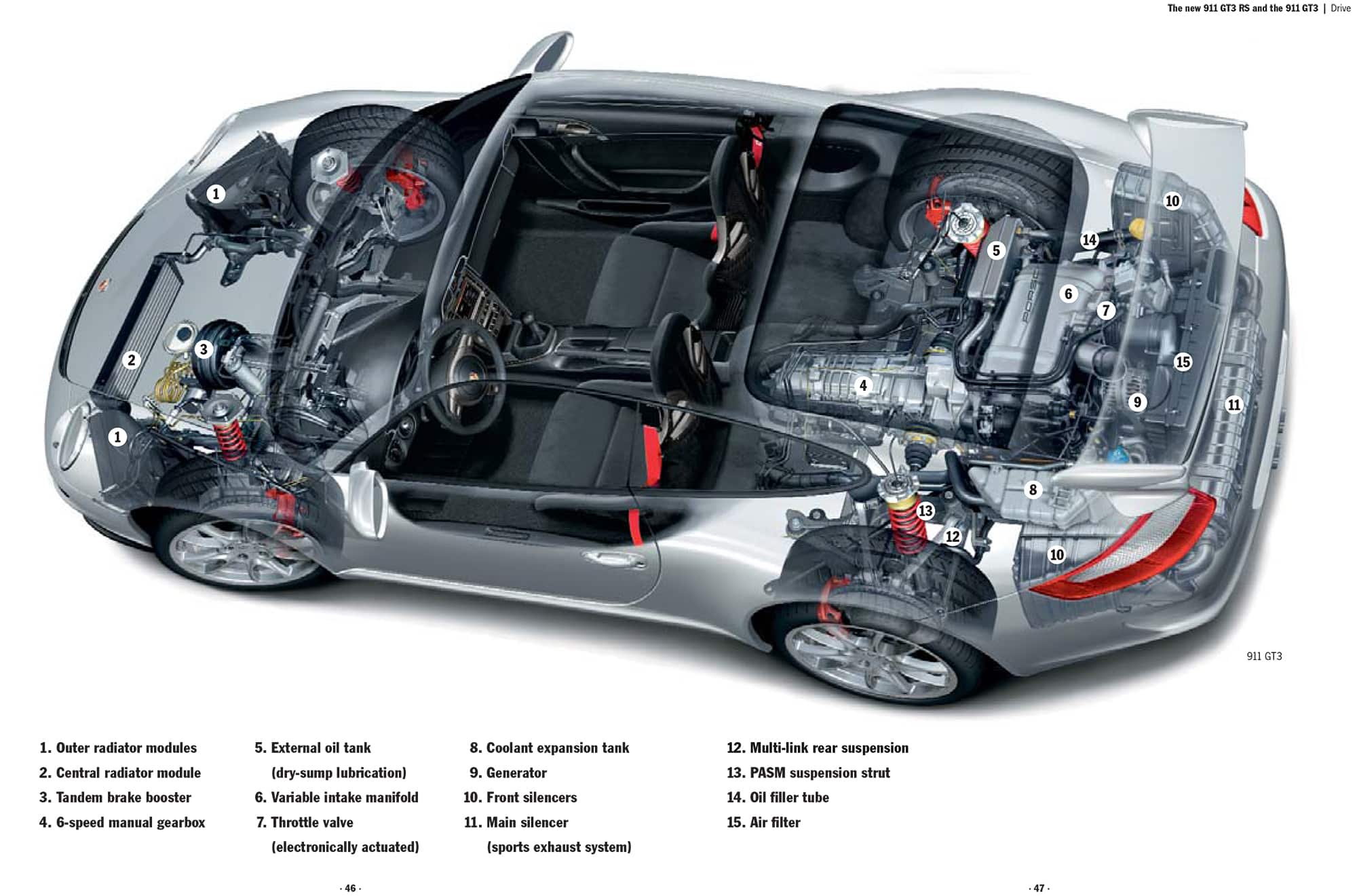
Porsche 911 997.2 GT3
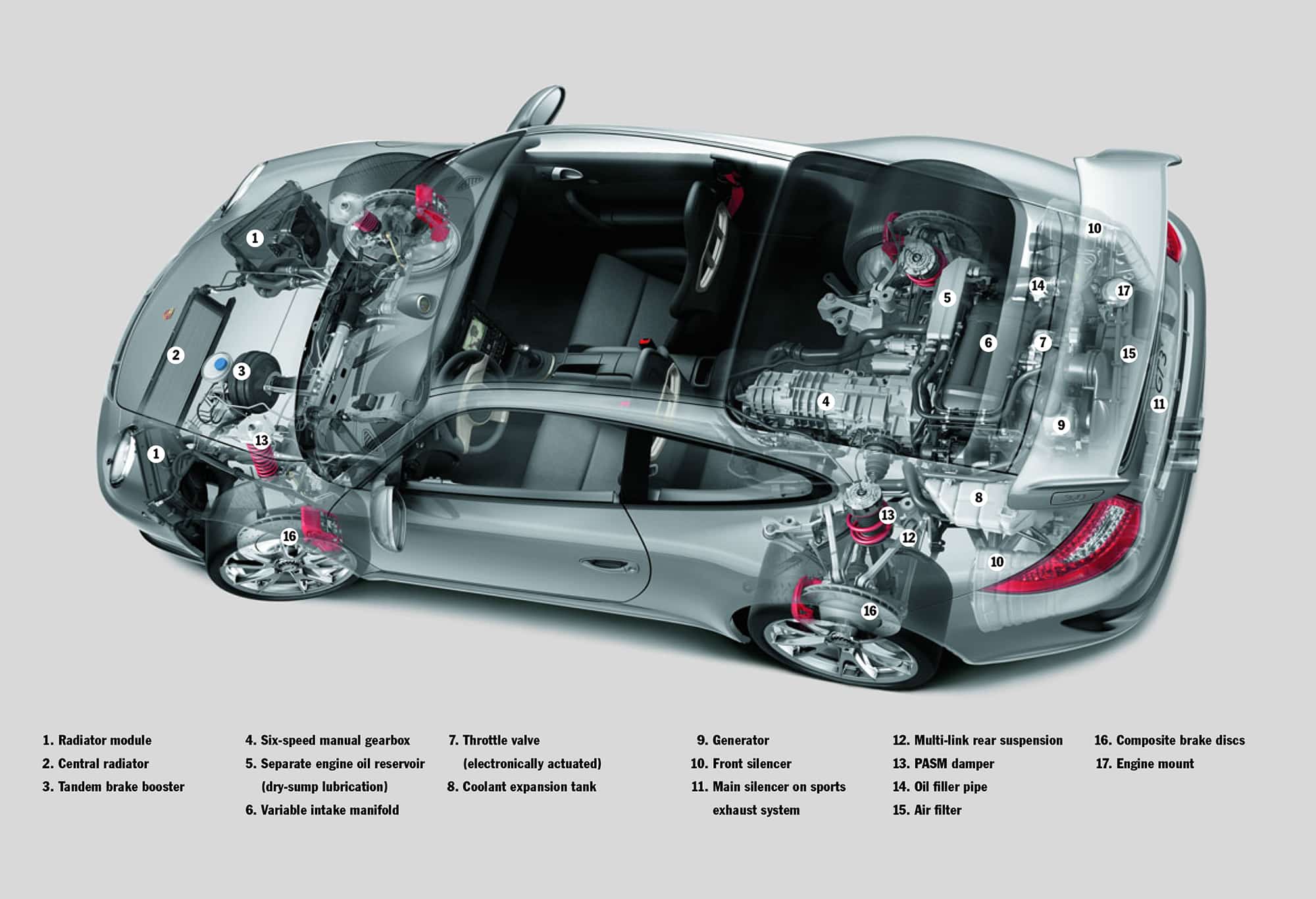
Chassis and Body
The 997 GT3 models use the Carrera 4S chassis, due to its structural rigidity and this has an advantage for the fuel tank to be positioned lower using the space where the front differential would normally fit in a 4S.
Despite using the 4S wider frame, the rear wing on the 997.1 is inherited from the Carrera 2, resulting in 44mm narrower body.
The 997 GT3 has the best hydraulic steering system available on any car produced with 2.65 turns between stops and it makes you question why the later generations went to electric steering systems. With the steering configuration, the 997 GT3 provides feedback to the driver like no other car giving control and confidence to push the limits.
The chassis featured on the new 911 GT3 RS and 911 GT3 is largely derived from the current GT3 racecar. Proven on the track, its sporting capability is also apparent on the road. Each car rides approximately 30 mm lower than the standard 911 Carrera. Lightweight design offers major weight savings, not least in terms of unsprung mass. The result: superlative handling, exceptional active safety and inherent stability, particularly when cornering.
The independent front suspension combines McPherson-type struts with longitudinal and transverse links. Each front wheel is precisely located, ensuring excellent handling and directional stability in all road and track scenarios. Brake spoiler elements provide efficient cooling for each of the front brake units.
The rear axle assembly consists of subframe-mounted multi-link suspension featuring LSA construction (Light, Stable, Agile). This lightened design is an important factor in the exceptional dynamics of each car.
Rear axle with Porsche Ceramic Composite Brake (PCCB) As on every racing Porsche, there are a number of suspension setup options. Ride height, camber, toe angle and anti-roll bar settings can all be adapted to individual circuit characteristics. The new 911 GT3 RS has split rear wishbones, enabling more accurate camber adjustment.
There is virtually no unwanted movement between the suspension and body, thanks to special features such as metal bearings on the front strut mounts. This reduced elasticity and improved wheel location enable better handling and turn-in.
The standard damper system offers full electronic adjustment in the form of Porsche Active Suspension Management (PASM). This continuous variable system offers two basic setup modes, ‘Normal’ and ‘Sport’.
For the first time ever, the 911 GT3 models are equipped with Traction Control (TC) as standard. Derived from the Carrera GT, this proven
technology combines ABD, ASR and MSR functionality. Specifically configured for optimum sports performance, Traction Control Front axle with Porsche Ceramic Composite Brake (PCCB) helps to eliminate wheelspin under full acceleration which could otherwise destabilise the rear of the car. The standard trigger threshold is purposely so high that it is rarely exceeded during normal road driving in the dry.
It is possible to raise the threshold higher still by pressing the ‘Sport’ button on the centre console. For maximum involvement, the system can be fully disabled using the separate ‘TC OFF’ switch.
The Porshe 911 997.1 and 997.2 cars used the same chassis and body, the 997.2 cars now had LED running lights in a new designed front bumper and Bi-Xenon headlights with LED rear lights.
The 911 997.1 GT3 RS and 911 GT3 run on one-piece 19-inch GT3 wheels, despite relatively large dimensions, the wheels are extremely light thanks to a specially devised alloy construction. The resulting reduction in unsprung mass offers a significant improvement in both driving dynamics and performance.
Another benefit of the wheel design is its inherent strength and rigidity.
The wheels run flush with the exterior of the car and come with special sport tyres as standard.The wheel dimensions are 8.5J x 19 with 235/35 ZR 19 tyres (front) and 12J x 19 with 305/30 ZR 19 tyres (rear). The rear hubs are fitted with 5-mm spacers creating a wider track. On the 911 GT3 RS, the rear wheels have a smaller offset to compensate for the wider body.
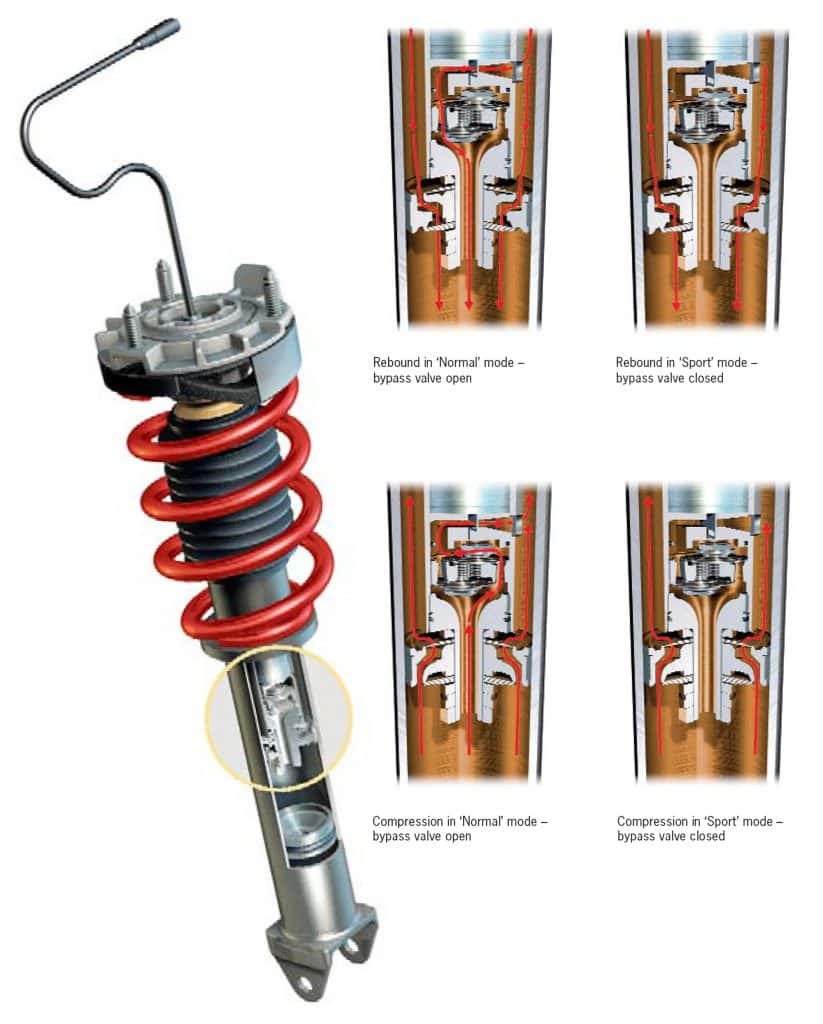
The 911 GT3 models are equipped with Porsche Active Suspension Management (PASM) as standard.
This active damping system offers continuous adjustment of individual damping forces based on current road conditions and driving style.
The driver can choose from two setup modes, ‘Normal’ and ‘Sport’, using a separate ‘damper’ button on the centre console. ‘Normal’ mode is designed for general road driving and circuits with uneven tarmac. ‘Sport’ mode is intended for smoother track surfaces, where the harder settings help eliminate pitch and roll.
In either mode, PASM continuously evaluates the current conditions while automatically selecting the corresponding damper rates from the respective set of mapped values.
A range of sensors are used to monitor the movement of the body during acceleration, braking and cornering manoeuvres, as well as on poor road surfaces. The PASM control unit then evaluates this data and modifies the damping force on each individual wheel in accordance with the selected mode. The result is a significant reduction in body movement as well as better grip on the road.
For example: if ‘Sport’ mode is selected, the suspension is automatically set to a harder damper rating. If the quality of the track surface falls below a
certain threshold, the system immediately changes to a softer rating within the ‘Sport’ setup range. When the quality of the tarmac improves once more,
PASM automatically returns to the original, harder rating.
The steering system is extremely direct and provides detailed feedback from the road. This high level of precision is extremely advantageous in both racing and normal road use.
An important feature of the steering system is the variableratio gearing. Around the straightahead position, the ratio is less direct, enabling smoother
manoeuvres on the motorway.
There is less risk of excessive steering inputs destabilising the car at high speed. Naturally, the system provides excellent feedback as well as the usual
agility.
As the wheel is turned harder, the ratio becomes more direct and the steering more responsive. This variability is particularly beneficial in low-speed hairpin bends.
Passive safety is also improved thanks to the collapsible steering column. In the event of frontal impact, the column can deform by as much as 100 mm.
The intermediate steering shaft is made from aluminium, while the protective tube and steering lock housing are die-cast magnesium.
The standard three-spoke GT3 steering wheel features manual height and reach adjustment. Used in conjunction with the seat adjustment options, it enables every driver to find the ideal seating position.
The result, of course, is an optimum connection between driver, car and road. On the 911 997 GT3 RS, the standard wheel has a straightahead
marker at the top of the rim. This provides the driver with a continuous overview of the steering angle on the front wheels.
The 911 GT3 models comply with all statutory requirements in respect of frontal, side, diagonal, rear impact and roll-over protection.
The bodyshell structure incorporates a highly resilient passenger cell offering exceptional crash protection. At the front of the car, the cell is protected by a patented system of longitudinal and transverse members (1).
Impact energy is largely absorbed, ensuring minimum deformation of the passenger cell.
Additional features include a highly rigid bulkhead crossmember (2) made from super high-strength steel. This element is designed to absorb impact
forces from the longitudinal members and thus protect both front footwells.
The upper section of each door features additional reinforcements (3) which enhance the overall rigidity of the car. In a frontal impact, this upper load
path (4) helps to channel energy into the sides of the body and thus further protect the passenger cell. In a minor collision, a system of easily
replaceable impact absorbers (5) prevents more serious damage to the bodyshell structure.
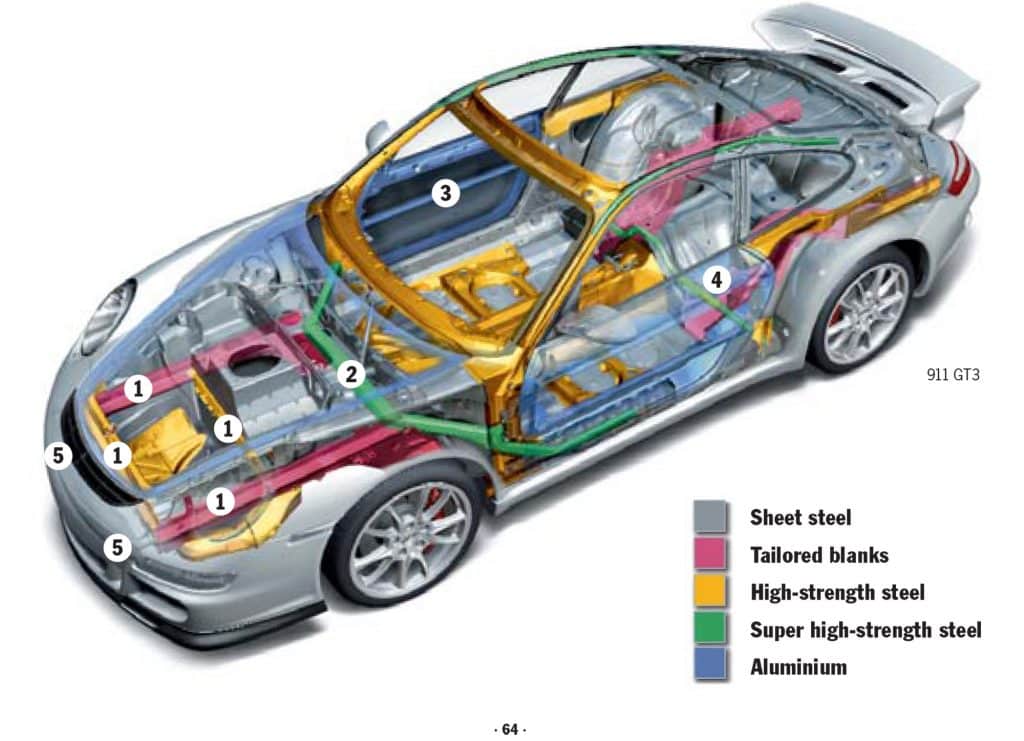
The 997.2 has centre lock wheels and some GT3 owners have had issues which make the 997.1 a simpler option yet again.
| 911 GT3 997.1 | 911 GT3 997.2 | 911 GT3 RS 997.1 | |
| Engine | |||
| Cylinders | 6 | 6 | 6 |
| Displacement | 3,600 cm3 | 3,797 cm3 | 3,600 cm3 |
| Max. power (DIN) | 305 kW (415 bhp) | 320 kW (435 hp) | 305 kW (415 bhp) |
| at | 7,600 rpm | 7,600 rpm | 7,600 rpm |
| Max. torque | 405 Nm | 430 Nm | 405 Nm |
| at | 5,500 rpm | 6,250 rpm | 5,500 rpm |
| Compression ratio | 12.0:1 | 12.0:1 | 12.0:1 |
| Transmission | |||
| Layout | Rear-wheel drive | Rear-wheel drive | Rear-wheel drive |
| Manual gearbox | 6-speed | 6-speed | 6-speed |
| Chassis | |||
| Front axle | McPherson-strut suspension | McPherson-strut suspension | McPherson-strut suspension |
| Rear axle | LSA multi-link suspension | LSA multi-link suspension | LSA multi-link suspension |
| Steering | Variable steering ratio, Variable | Power-assisted (hydraulic), | Variable steering ratio, Variable |
| power-assisted (hydraulic) | with variable steering ratio | power-assisted (hydraulic) | |
| Turning circle | 10.9 m | 10.9 m | 10.9 m |
| Brakes | 6-piston monobloc aluminium fixed | Six-piston aluminium monobloc fixed calipers | 6-piston monobloc aluminium fixed |
| calipers at front, 4-piston monobloc | at front and four-piston aluminium monobloc fixed | calipers at front, 4-piston monobloc | |
| aluminium fixed calipers at rear, discs | calipers at rear, composite brake discs internally | aluminium fixed calipers at rear, discs | |
| internally vented and cross-drilled | vented and cross-drilled | internally vented and cross-drilled | |
| Vehicle stability system | x | Porsche Stability Management (PSM) | x |
| Anti-lock braking system | ABS 8.0 | ABS 8.0 (incorporated in PSM) | ABS 8.0 |
| Wheels | Front: 8.5J x 19 ET 53 | Front: 8.5J x 19 ET 53 | Front: 8.5J x 19 ET 53 |
| Rear: 12J x 19 ET 68 | Rear: 12J x 19 ET 63 | Rear: 12J x 19 ET 68 | |
| Tyres | Front: 235/35 ZR 19 | Front: 235/35 ZR 19 | Front: 235/35 ZR 19 |
| Rear: 305/30 ZR 19 | Rear: 305/30 ZR 19 | Rear: 305/30 ZR 19 | |
| Weights | |||
| Unladen weight (DIN) | 1,395 kg | 1,395 kg | 1,375 kg |
| Unladen weight (EC)* | 1,470 kg | 1,470 kg | 1,450 kg |
| Permissible gross weight | 1,680 kg | 1,680 kg | 1,680 kg |
| Performance | |||
| Top speed | 310 km/h (193 mph) | 312 km/h (194 mph) | 310 km/h (193 mph) |
| 0–100 km/h (0–62 mph) | 4.3 secs | 4.1 secs | 4.2 secs |
| 0–160 km/h (0–99 mph) | 8.7 secs | 8.2 secs | 8.5 secs |
| 0–200 km/h (0–124 mph) | 13.8 secs | 12.3 secs | 13.8 |
| Flexibility 80–120 km/h | |||
| (50–75 mph) in 5th gear | 6.2 secs | 5.9 secs | 6.1 secs |
| Fuel consumption/emissions | |||
| In accordance with 80/1268/EC | |||
| Urban | 19.8 l/100 km (14.3 mpg) | 19.8 (14.3) | 19.8 l/100 km (14.3 mpg) |
| Extra urban | 8.9 l/100 km (31.7 mpg) | 8.9 (31.7) | 8.9 l/100 km (31.7 mpg) |
| Combined | 12.8 l/100 km (22.1 mpg) | 12.8 (22.1) | 12.8 l/100 km (22.1 mpg) |
| CO2 emissions | 307 g/km | 303 g/km | 307 g/km |
| Dimensions/aerodynamics | |||
| Length | 4,445 mm | 4,465 mm | 4,460 mm |
| Width | 1,808 mm | 1,808 mm | 1,852 mm |
| Height | 1,280 mm | 1,280 mm | 1,280 mm |
| Wheelbase | 2,355 mm | 2,355 mm | 2,360 mm |
| Luggage compartment volume | 105 litres | 105 litres | 105 litres |
| Tank capacity (refill volume) | 90 litres | 67 litres | 90 litres |
| Drag coefficient | 0.29 | 0.32 | 0.3 |
Conclusion: Which Is Best? 911 997.1 or 997.2 GT3
Both the 911 997 GT3 .1 and .2 generations are amazing cars, and as technology advances forwards for the right reasons the 997.2 took on some digital elements when compared to the 997.1 which means that the gen 1 cars are the last truly analog GT3. With no LEDs, and fewer emission restrictions allowing engineers to produce a 3.6 engine that has the most amazing power delivery ever and when you compare the NM torque curves you can clearly see the linear differences between the 3.6 and 3.8 and also much greater reliability.
The new developments of the 3.8 engine were groundbreaking but the changes over the 3.6 and additional technology have removed some of the raw qualities and pureness, the additional LEDs and daytime running lights, and various other electronic changes make the 997.2 GT3 a much more complicated car and it is closer to the 991 than the 997.1 making the generation 1 car a true analog masterpiece and the last pure 911 GT3 which will never happen again.
Buy a 997.1 GT3 whilst you still can, with such low build numbers compared to the 991 GT3's as the years go by these amazing cars are becoming even rarer than the day they were made!
